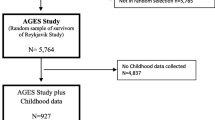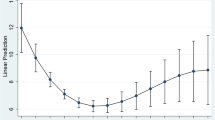Abstract
Background:
An association between depression and obesity is well recognised, but longitudinal studies of depressive symptoms in adolescents as a predictor of body composition are lacking.
Objective:
We examined depressive symptoms at age 14, 17 and 20 years as predictors of lean, fat and bone mass at age 20 years in a birth cohort.
Subjects/Methods:
In 1161 participants (569 females) in the Western Australia Pregnancy Cohort (Raine) Study, depressive symptoms were assessed using the Beck Depression Inventory for Youth at age 14 and 17 years, and the Depression, Anxiety and Stress Scale 21 at age 20 years. Participants were further classified into two trajectories using latent class analysis: no/transient and persistent/recurrent depression. At age 20 years, lean body mass (LBM), fat body mass (FBM) and total body bone mass were measured by dual-energy X-ray absorptiometry.
Results:
In females, accounting for age and lifestyle factors, depression scores at age 14 and 20 years were positively associated with body weight, body mass index (BMI), FBM and % FBM (r=0.110–0.184, P<0.05) but negatively correlated with % LBM (r=−0.120, P<0.05) at age 20 years. Females in the persistent/recurrent depression trajectory (n=99) had significantly higher body weight (+5.1 kg), BMI (+1.8 kg m−2), FBM (+3.9 kg) and % FBM (+2.2%) and significantly lower % LBM (−2.2%) at age 20 years than those with no/transient depression (n=470; all P<0.05). In males, depression scores at age 17 and 20 years were negatively associated with LBM but not weight or BMI, and depression trajectory was not a predictor of body composition at age 20 years. Depression scores and trajectories did not predict bone mass in either males or females.
Conclusions:
Depressive symptoms and persistent/recurrent depression in adolescence are predictors of greater adiposity at age 20 years in females, but not males, but do not predict bone mass in either gender.

Similar content being viewed by others
References
Hasler G, Pine DS, Kleinbaum DG, Gamma A, Luckenbaugh D, Ajdacic V et al. Depressive symptoms during childhood and adult obesity: the Zurich Cohort Study. Mol Psychiatry 2005; 10: 842–850.
Van Strien T, Schippers GM, Cox WM . On the relationship between emotional and external eating behavior. Addict Behav 1995; 20: 585–594.
Heuser I . Anna-Monika-Prize paper. The hypothalamic-pituitary-adrenal system in depression. Pharmacopsychiatry 1998; 31: 10–13.
Anderson SE, Cohen P, Naumova EN, Jacques PF, Must A . Adolescent obesity and risk for subsequent major depressive disorder and anxiety disorder: prospective evidence. Psychosom Med 2007; 69: 740–747.
Richardson LP, Davis R, Poulton R, McCauley E, Moffitt TE, Caspi A et al. A longitudinal evaluation of adolescent depression and adult obesity. Arch Pediatr Adolesc Med 2003; 157: 739–745.
Goodman E, Whitaker RC . A prospective study of the role of depression in the development and persistence of adolescent obesity. Pediatrics 2002; 110: 497–504.
Li Y, Meng L, Li Y, Sato Y . Depression-related differences in lean body mass distribution from National Health and Nutrition Examination Survey 2005-2006. J Affect Disord 2014; 157: 1–7.
Morrison KM, Shin S, Tarnopolsky M, Taylor VH . Association of depression and health related quality of life with body composition in children and youth with obesity. J Affect Disord 2015; 172: 18–23.
Cizza G, Primma S, Coyle M, Gourgiotis L, Csako G . Depression and osteoporosis: a research synthesis with meta-analysis. Horm Metab Res 2010; 42: 467–482.
Mussolino ME, Jonas BS, Looker AC . Depression and bone mineral density in young adults: results from NHANES III. Psychosom Med 2004; 66: 533–537.
Oh SM, Kim HC, Kim KM, Ahn SV, Choi DP, Suh I . Association between depressive symptoms and bone stiffness index in young adults: the Kangwha study. PLoS One 2013; 8: e69929.
Eskandari F, Martinez PE, Torvik S, Phillips TM, Sternberg EM, Mistry S et al. Low bone mass in premenopausal women with depression. Arch Intern Med 2007; 167: 2329–2336.
McKnight CM, Newnham JP, Stanley FJ, Mountain JA, Landau LI, Beilin LJ et al. Birth of a cohort—the first 20 years of the Raine study. Med J Aust 2012; 197: 608–610.
Newnham JP, Evans SF, Michael CA, Stanley FJ, Landau LI . Effects of frequent ultrasound during pregnancy: a randomised controlled trial. Lancet 1993; 342: 887–891.
Robinson M, Oddy WH, McLean NJ, Jacoby P, Pennell CE, de Klerk NH et al. Low-moderate prenatal alcohol exposure and risk to child behavioural development: a prospective cohort study. BJOG 2010; 117: 1139–1150.
Beck S, Beck AT, Jolly J . Beck Youth Inventory. Psychological Corporation: New York, USA, 2001.
Beck AT, Steer RA, Brown GK . Beck Depression Inventory, 2nd edn. The Psychological Corporation: San Antonio, USA, 1996.
Eack SM, Singer JB, Greeno CG . Screening for anxiety and depression in community mental health: the beck anxiety and depression inventories. Community Ment Health J 2008; 44: 465–474.
Lovibond SH, Lovibone PF . Manual for the Depression Anxiety Stress Scales, 2nd edn. Psychology Foundation: Sydney, Australia, 1995.
Antony MM, Bieling PJ, Cox BJ, Enns MW, Swinson RP . Psychometric properties of the 42-item and 21-item versions of the Depression Anxiety Stress Scales in clinical groups and a community sample. Psychol Assess 1998; 10: 176–181.
Collins L, Lanza S . Latent Class and Latent Transition Analysis: with Applications in the Social, Behavioural and Health Sciences. John Wiley and Sons Inc.: Hoboken, USA, 2010.
Hodge A, Patterson AJ, Brown WJ, Ireland P, Giles G . The Anti Cancer Council of Victoria FFQ: relative validity of nutrient intakes compared with weighed food records in young to middle-aged women in a study of iron supplementation. Aust NZ J Public Health 2000; 24: 576–583.
Craig CL, Marshall AL, Sjostrom M, Bauman AE, Booth ML, Ainsworth BE et al. International physical activity questionnaire: 12-country reliability and validity. Med Sci Sports Exerc 2003; 35: 1381–1395.
Erickson SJ, Robinson TN, Haydel KF, Killen JD . Are overweight children unhappy?: body mass index, depressive symptoms, and overweight concerns in elementary school children. Arch Pediatr Adolesc Med 2000; 154: 931–935.
**e B, Chou CP, Spruijt-Metz D, Liu C, **a J, Gong J et al. Effects of perceived peer isolation and social support availability on the relationship between body mass index and depressive symptoms. Int J Obes (Lond) 2005; 29: 1137–1143.
de Wit L, Luppino F, van Straten A, Penninx B, Zitman F, Cuijpers P . Depression and obesity: a meta-analysis of community-based studies. Psychiatry Res 2010; 178: 230–235.
Pine DS, Goldstein RB, Wolk S, Weissman MM . The association between childhood depression and adulthood body mass index. Pediatrics 2001; 107: 1049–1056.
Stubbs B, Koyanagi A, Schuch FB, Firth J, Rosenbaum S, Veronese N et al. Physical activity and depression: a large cross-sectional, population-based study across 36 low- and middle-income countries. Acta Psychiatr Scand 2016; 134: 546–556.
Josefsson T, Lindwall M, Archer T . Physical exercise intervention in depressive disorders: meta-analysis and systematic review. Scand J Med Sci Sports 2014; 24: 259–272.
Kerling A, von Bohlen A, Kuck M, Tegtbur U, Grams L, Haufe S et al. Exercise therapy improves aerobic capacity of inpatients with major depressive disorder. Brain Behav 2016; 6: e00469.
Forbes EE, Williamson DE, Ryan ND, Birmaher B, Axelson DA, Dahl RE . Peri-sleep-onset cortisol levels in children and adolescents with affective disorders. Biol Psychiatry 2006; 59: 24–30.
Shores MM, Sloan KL, Matsumoto AM, Moceri VM, Felker B, Kivlahan DR . Increased incidence of diagnosed depressive illness in hypogonadal older men. Arch Gen Psychiatry 2004; 61: 162–167.
Lourenco S, Lucas R, da Silva DF, Ramos E, Barros H . Depressive symptoms are not associated with forearm bone accrual during adolescence. Arch Osteoporos 2014; 9: 173.
Baxter-Jones AD, Faulkner RA, Forwood MR, Mirwald RL, Bailey DA . Bone mineral accrual from 8 to 30 years of age: an estimation of peak bone mass. J Bone Miner Res 2011; 26: 1729–1739.
Luppino FS, de Wit LM, Bouvy PF, Stijnen T, Cuijpers P, Penninx BW et al. Overweight, obesity, and depression: a systematic review and meta-analysis of longitudinal studies. Arch Gen Psychiatry 2010; 67: 220–229.
Acknowledgements
We thank the efforts of the Raine Study participants and the Raine Study team for study co-ordination and data collection. Core funding for the Raine Study is provided by The University of Western Australia (UWA), Telethon Kids Institute, Raine Medical Research Foundation, UWA Faculty of Medicine, Dentistry and Health Sciences, Women’s and Infant’s Research Foundation, Curtin University and Edith Cowan University. The 20-year cohort follow-up assessment was funded by project grants from the Australian National Health and Medical Research Council and funding from the Lions Eye Institute, Nedlands, Western Australia. The Canadian Institutes of Health Research funded the DXA data collection (CIHR, Lye et al, MOP-82893).
Author information
Authors and Affiliations
Corresponding author
Ethics declarations
Competing interests
The authors declare no conflict of interest.
Rights and permissions
About this article
Cite this article
Zhu, K., Allen, K., Mountain, J. et al. Depressive symptoms, body composition and bone mass in young adults: a prospective cohort study. Int J Obes 41, 576–581 (2017). https://doi.org/10.1038/ijo.2016.214
Received:
Revised:
Accepted:
Published:
Issue Date:
DOI: https://doi.org/10.1038/ijo.2016.214
- Springer Nature Limited
This article is cited by
-
Non-melancholic depressive symptoms are associated with above average fat mass index in the Helsinki birth cohort study
Scientific Reports (2022)
-
Association of depression, anxiety and menopausal-related symptoms with demographic, anthropometric and body composition indices in healthy postmenopausal women
BMC Women's Health (2021)




